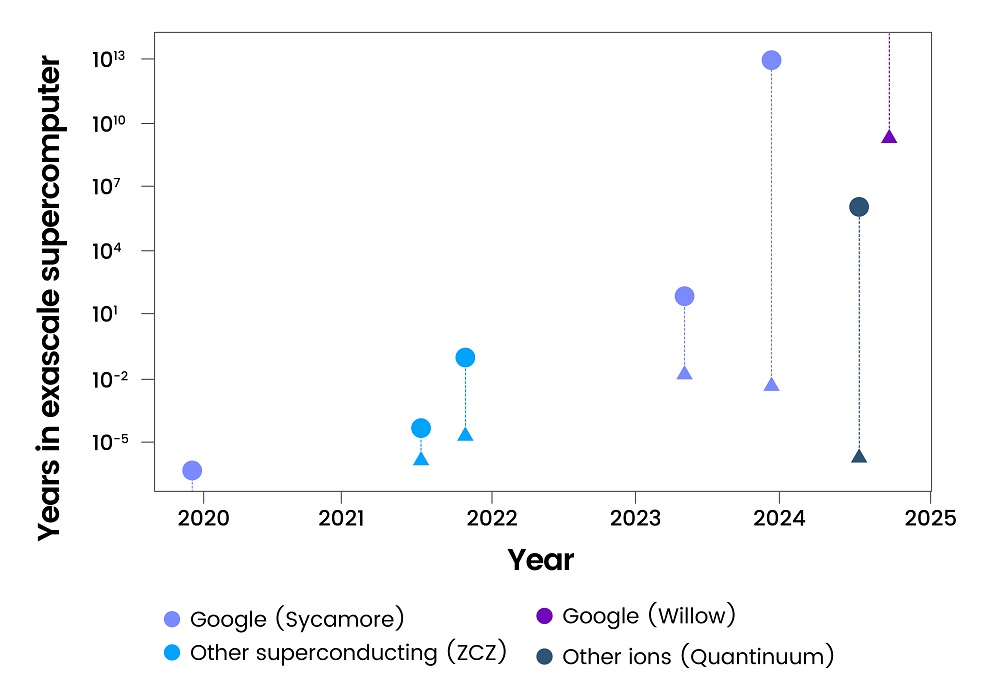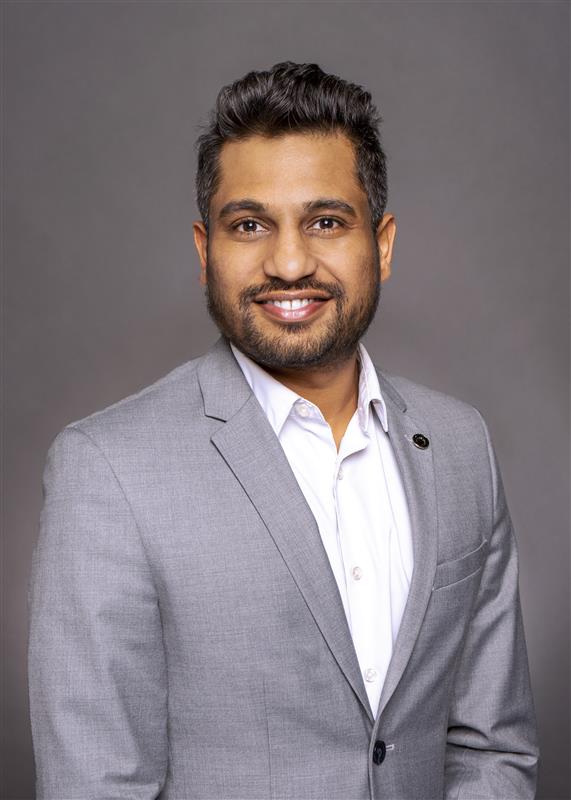In a landscape dominated by AI headlines, Google's Quantum Chip Willow marked a technological breakthrough in 2024. It accomplished what supercomputers are incapable of by solving complex problems in minutes that would have otherwise taken years.
The journey of quantum computing began in 1900 with Max Planck's discovery of energy quanta, and now, 124 years later, Google’s Willow chip marks a transformative milestone. It has the means to drastically reduce errors as the number of qubits increases, which has been a key challenge since the introduction of quantum error correction in 1995. Scaling up quantum systems worsens errors made by qubits owing to environmental interaction, reducing their dependability. Willow overcomes this obstacle, which has hindered progress for nearly three decades, marking a critical step toward building reliable quantum computers.
Figure 1: Willow Leads the Way in Quantum Computational Efficiency

Scenario ▲: Unlimited Memory
Scenario ⬤: Parallel Implementation on GPUs
Source: Google
Additionally, Willow executed a benchmark computation in less than five minutes, which would take the fastest computers 10 septillion years (10²⁵) to complete. With 105 qubits, double that of its predecessor, the Sycamore chip, it achieves industry-leading performance on two critical benchmarks: quantum error correction and random circuit sampling. These are key indicators of a chip’s overall capabilities. It also demonstrates significant hardware advancements, as its qubits feature vastly improved retention times (T1 times), holding information around five times longer than previous chips. This improvement is vital for enhancing stability and accuracy in quantum operations.
Read more: Charting New Horizons in Private Credit
Addressing Encryption Threats
Quantum computing presents a significant threat to modern encryption methods like RSA, which rely on problems tougher for classical computers to solve. In 1994, Peter Shor illustrated that a powerful quantum computer would likely dismantle RSA encryption, potentially jeopardizing digital certificates, cryptocurrencies, and email security. However, with its 105 qubits, Willow remains far from achieving this capability. Kevin Rose, a tech entrepreneur and former senior product manager at Google, estimates that breaking encryption like Bitcoin’s would require approximately 13 million qubits to decrypt data within 24 hours.
While such a breakthrough is distant, the timeline to achieve quantum-resistant systems is shortening. Organizations like PQShield are developing post-quantum cryptographic (PQC) defenses, including NIST-standardized algorithms, to withstand future quantum attacks. The NSA urges enterprises to adopt PQC as early as 2025, warning that data stolen currently will likely be decrypted once sufficiently advanced quantum systems emerge. Google’s progress underscores the urgency for global efforts to ensure systems are quantum-ready and resilient.
Accelerating AI
Willow holds the potential to revolutionize artificial intelligence (AI) by significantly enhancing machine learning (ML) and neural network capabilities. Quantum computing’s immense computational power will tackle problems that classical systems struggle to model, unlocking unprecedented AI advancements. However, experts like DeepMind’s Demis Hassabis suggest that advanced AI on classical machines is expected to reduce reliance on quantum systems. Despite this argument, even in niche applications, Willow will likely accelerate AI development to drive significant breakthroughs in computation and innovation.

Challenges Remain
Despite its promise as a groundbreaking advancement, Willow faces several challenges. While it demonstrates a significant technical leap, experts emphasize the lack of practical applications for quantum computing at this stage. Francesco Ricciuti of Runa Capital notes that Google’s results are derived from benchmarks that do not meaningfully tackle complex, real-world calculations. Willow’s 105 qubits, while notable, remain insufficient to address industry problems, as solving these would require millions of qubits, according to Winfried Hensinger, a quantum technology professor.
Additionally, its reliance on superconducting qubits requires near-absolute-zero temperatures for stability, potentially limiting the system’s scalability. A theoretical physicist from the California Institute of Technology, John Preskill, stresses the need to enable protected qubit operations rather than just memory. Building robust logical qubits and interconnecting them to share quantum states adds complexity. Lastly, a shortage of skilled professionals in quantum computing poses a barrier to advancing technologies like Willow.
Read more: Trump’s Tariff Threat: Will it Strengthen the US or Strain the World
Looking Forward
Google's Willow chips hold potential for future quantum computing, aiming to achieve beyond-classical computation that addresses real-world problems. So far, progress has been made on two fronts. First, running the RCS benchmark, which tests performance against classical computers but lacks practical applications, and second, conducting scientifically meaningful simulations of quantum systems that, while insightful, remain achievable with classical methods.
With Willow, Google is optimistic about quantum computing's transition from experimental success to real-world utility, with practical applications expected within five years. However, this evolution won’t be instantaneous. As the limits of efficient computation evolve, a hybrid phase emerges in which quantum and classical hardware will work together. Targeted software and integrated systems will help identify optimal problems, paving the way for unprecedented performance levels and ultimately redefining what technology will achieve.
Partner of choice for lower middle market-focused investment banks and private equity firms, SG Analytics provides offshore analysts with support across the deal life cycle. Our complimentary access to a full back-office research ecosystem (database access, graphics team, sector & and domain experts, and technology-driven automation of tactical processes) positions our clients to win more deal mandates and execute these deals in the most efficient manner.
About SG Analytics
SG Analytics (SGA) is an industry-leading global data solutions firm providing data-centric research and contextual analytics services to its clients, including Fortune 500 companies, across BFSI, Technology, Media & Entertainment, and Healthcare sectors. Established in 2007, SG Analytics is a Great Place to Work® (GPTW) certified company with a team of over 1200 employees and a presence across the U.S.A., the UK, Switzerland, Poland, and India.
Apart from being recognized by reputed firms such as Gartner, Everest Group, and ISG, SGA has been featured in the elite Deloitte Technology Fast 50 India 2023 and APAC 2024 High Growth Companies by the Financial Times & Statista.









